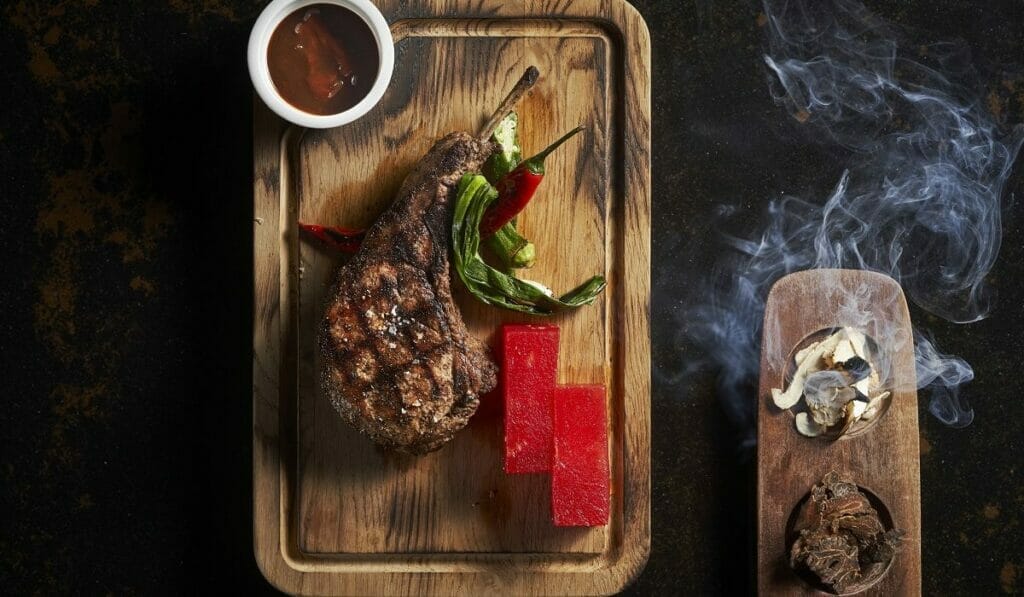Chef-restaurateur Alvin Leung slaps a beautiful piece of bone-in pork chop on a charcoal grill, prodding it with a pair of tongs to encourage drippings from the meat to create flare-ups on the charcoal. “You’ve got to do this when you grill the meat to give it a smoky flavour,†shares the self-styled “Demon Chef†— a moniker that Leung has claimed comes from the Greek daimon, meaning “good spiritednessâ€. Was Leung in good spirits? Possibly, as much as one can be after arriving in a long-haul flight from Canada to Singapore, and clinging on to cups of coffee throughout the day.
As he demonstrates his dish of a Hokkien-style bak kut teh inspired pork chop, the chef of the three-Michelin starred Bo Innovation insists that he isn’t here to cook an “Xtreme†version of Singaporean cuisine. No chicken rice ice cream or molecular anything, only food to comfort and satiate.
The opening of 15 Stamford at The Capitol Kempinski Hotel Singapore marks Leung’s second restaurant in Singapore after Peking duck concept Forbidden Duck. The development for both restaurants couldn’t have been more different though. While Forbidden Duck was mostly Leung, 15 Stamford was created with more limitations already in place — it’s a collaboration with the Kempinski brand, and Leung had to develop the restaurant in situ as the space — including the kitchen — was already built before he was brought on.

The interior of 15 Stamford
Conceptualised by the late Jaya Ibrahim, much of the interior of Capitol Kempinski, including the restaurant space, features the renowned designer’s distinctive clean, structural lines balanced with wood and subtle Asian detailing. As befitting a public dining space, art deco elements give the restaurant a New York brasserie feel that tempers the softness of Jaya’s usual designs. It’s a fitting space for Leung’s concept too, as there are no attempts to be derivative, and overtly Singaporean or even Asian — something Leung is clearly careful about, given how people can be extremely protective of their own cuisine.
“I’m not here to reinvent bak kut teh, the dish is just inspired by bak kut teh,†Leung declares. Having eaten and travelled extensively in the region, and picking up the skills and nuances of local cuisine in the course of doing so, Leung feels that he could at least draw from these experiences for the food at 15 Stamford.
“Am I qualified? I think so… but you can eat the food, and then make your judgement,†challenges Leung.
Eating at 15 Stamford
With his ever-changing hair colour (it’s currently green), earring and tinted glasses, Leung cuts a figure more rock star than chef, but taste the food and it’s evident that his current preoccupations — being a restaurateur and appearing on television — have not diminished his ability to come up with good dishes.
Standouts include the aforementioned bak kut teh pork chop, inspired by the herbal, Hokkien/Kuala Lumpur version of the dish. Here, a bone-in pork chop is marinated with bak kut teh spices before being grilled on the massive charcoal-fried pit that sits in the centre of the open kitchen.
While eight different herbs and spices are used in the marinade, the most dominant of which would be Chinese angelica, or dang gui. The bittersweet herb also features in other elements of the dish: compressed watermelon, and a rich barbecue sauce. It’s a couple of degrees removed from its inspiration, but it works as the angelica’s pungency (almost like a more robust ginseng) stands up well to the smoky, tender pork.
Besides Singapore, the other parts of Southeast Asia have also inspired many of the dishes. Seared Hokkaido scallops sits in a beurre blanc-like, brown-hued butter sauce with the unmistakable sour-sweet-garlic tang of Filipino adobo. A whole Boston lobster, its sweet flesh kissed by grill smoke, comes dressed with an inspired (and very judiciously sweetened) sauce of mangosteen and garlicky, spicy Thai chilli.

Boston lobster with mangosteen and spicy Thai dressing
If you’ve followed Leung’s cooking, you’ll also find his stamp (besides the literal ones found as motifs on the tableware) on some items of the menu: flourishes, and flavour combinations that he seems rather fond of — pairing sweet Pat Chun vinegar with charred corn in a dish of corn three ways (charred buttered corn, baby corn, and popcorn), served alongside marinated heirloom tomatoes and cucumbers; and twin umami bombs of homemade dried shrimp oil and shrimp floss, which are added to a potent Nonya laksa.

15 Stamford’s Singaporean laksa
The laksa is as close to the “original†version of a local dish as it gets, with the rice noodles cut into spoonable pieces, Katong laksa-style; although this one does come with tiger prawn tempura and gooey-centered ajitsuke quail eggs smoked with jasmine tea.
Other dishes will be somewhat familiar — meltingly-tender 72 hour slow cooked rendang short ribs, coated in a lemak, reduced rendang sauce; and a clearly yu sheng-inspired dish of raw hamachi splashed with calamansi ponzu and sesame, dotted with calamansi gel and fried garlic chips.



